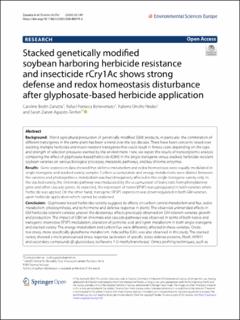| dc.description.abstract | Background World agricultural production of genetically modified (GM) products, in particular, the combination of different traits/genes in the same plant has been a trend over the last decade. There have been concerns raised over stacking multiple herbicide and insect-resistant transgenes that could result in fitness costs depending on the type and strength of selection pressures exerted by the environment. Here, we report the results of transcriptomic analysis comparing the effect of glyphosate-based herbicide (GBH) in the single-transgene versus stacked, herbicide-resistant soybean varieties on various biological processes, metabolic pathways, and key shikimic enzymes. Results Gene expression data showed that defense metabolism and redox homeostasis were equally modulated in single-transgene and stacked-variety samples. Carbon accumulation and energy metabolisms were distinct between the varieties and photosynthesis metabolism was found negatively affected in the single-transgene variety only. In the stacked variety, the shikimate pathway was modulated by the accumulation of transcripts from phenylalanine gene and other cascade genes. As expected, the expression of native EPSPS was upregulated in both varieties when herbicide was applied. On the other hand, transgenic EPSPS expression was down-regulated in both GM varieties upon herbicide application which cannot be explained. Conclusion Glyphosate-based herbicides toxicity suggests its effects on carbon central metabolism and flux, redox metabolism, photosynthesis, and to hormone and defense response in plants. The observed unintended effects in GM herbicide-tolerant varieties unravel the deleterious effects previously observed on GM-tolerant varieties growth and production. The impact of GBH on shikimate and cascade pathways was observed in terms of both native and transgenic insensitive EPSPS modulation, alteration of jasmonic acid and lignin metabolism in both single-transgene and stacked variety. The energy metabolism and carbon flux were differently affected in these varieties. Oxidative stress, more specifically glutathione metabolism, induced by GBH, was also observed in this study. The stacked variety showed a more pronounced stress response (activation of specific stress defense proteins, Rboh, WRKY) and secondary compounds (β-glucosidase, isoflavone 7-O-methyltransferase). Omics profiling techniques, such as transcriptomics, can be considered tools to support risk assessment in detecting unintended effects due to the GBH application. | en_US |

